Incorporating plants into your home decor is not just a trend; it’s a way to enhance your living space with life, color, and health benefits. As we spend more time indoors, especially in urban environments, the need to connect with nature becomes increasingly important. This article explores various creative ways to integrate plants into your decor, offering practical tips and insights into the benefits of having greenery in your home.
The Benefits of Indoor Plants
- Improved Air Quality: Indoor plants can help purify the air by absorbing toxins and releasing oxygen. Studies have shown that houseplants can remove harmful substances like formaldehyde and benzene from indoor environments.
- Enhanced Mood and Well-being: Being around plants has been linked to reduced stress and anxiety levels. Research indicates that interacting with plants can lower blood pressure and promote feelings of calmness.
- Increased Productivity: In workspaces, the presence of plants has been shown to boost productivity and creativity. Employees in environments with greenery tend to perform better and feel more satisfied with their work.
- Aesthetic Appeal: Beyond their health benefits, plants add beauty and vibrancy to any space. They can transform a dull room into a lively sanctuary.
Creative Ways to Incorporate Plants into Your Decor
1. Vertical Gardens

- DIY Vertical Planters: Create your own vertical garden using wall-mounted planters or repurposed wooden pallets. Choose trailing plants like Pothos or String of Hearts for a cascading effect.
- Pre-made Kits: If DIY isn’t your style, consider purchasing pre-made vertical garden kits that come with everything you need to get started.
2. Hanging Planters

- Macrame Hangers: Use macrame plant hangers for a bohemian touch. They work well in living rooms, bedrooms, or even kitchens.
- Suspended Shelves: Install shelves that allow you to hang pots at varying heights, creating an eye-catching display that draws the eye upward.
3. Plant Stands

- Multi-tiered Stands: Use multi-tiered plant stands to showcase different types of plants at varying heights. This creates visual interest and allows for better light exposure for all plants.
- Repurposed Furniture: Consider using old stools or side tables as plant stands for a unique look that blends functionality with style.
4. Grouping Plants

- Variety in Size and Texture: Combine plants of different sizes, shapes, and textures for an eclectic look. Pair tall snake plants with smaller succulents or ferns.
- Cohesive Color Schemes: Use pots in similar colors or materials to unify the display while still allowing for diversity in plant species.
5. Using Plants as Decor Elements

- Centerpieces: Use larger plants as centerpieces on dining tables or coffee tables. A tall plant can act as a natural divider in open spaces.
- Decorative Bowls or Jars: Display smaller plants in decorative bowls or glass jars filled with pebbles or colored stones for added flair.
6. Incorporating Plants into Functional Spaces

- Kitchen Herb Gardens: Grow herbs like basil, rosemary, or mint in small pots on kitchen windowsills for easy access while cooking.
- Bathroom Plants: Choose humidity-loving plants like ferns or orchids for bathrooms, creating a spa-like atmosphere while thriving in moist conditions.
7. Wall Art with Plants

- Geometric Wall Mounts: Use geometric wall mounts for air plants or small potted varieties. These can be arranged in patterns for a modern art effect.
- Plant Frames: Create framed plant displays using moss or small succulents within shadow boxes for a unique touch.
8. Seasonal Displays

- Holiday Themes: During holidays, incorporate seasonal decorations alongside small potted plants that reflect the festive spirit.
- Seasonal Rotations: Rotate your plant selection based on seasonal blooms or foliage changes, ensuring your space feels alive throughout the year.
9. Utilizing Unused Spaces

- Corners and Ledges: Fill empty corners with tall floor plants like fiddle leaf figs or palms that draw attention without overwhelming the space.
- Shelving Units: Use open shelving units not just for books but also as displays for various houseplants interspersed with decorative items.
Conclusion
Bringing nature indoors through creative plant incorporation not only enhances the aesthetic appeal of your home but also contributes positively to your mental and physical well-being. By experimenting with various styles—such as vertical gardens, hanging planters, and grouped displays—you can create a personalized oasis that reflects your taste while benefiting from the numerous advantages that indoor plants provide. Whether you're an experienced gardener or just starting out, there are countless ways to enjoy the beauty and benefits of greenery within your living spaces. Embrace the joy of indoor gardening and let nature flourish inside your home!